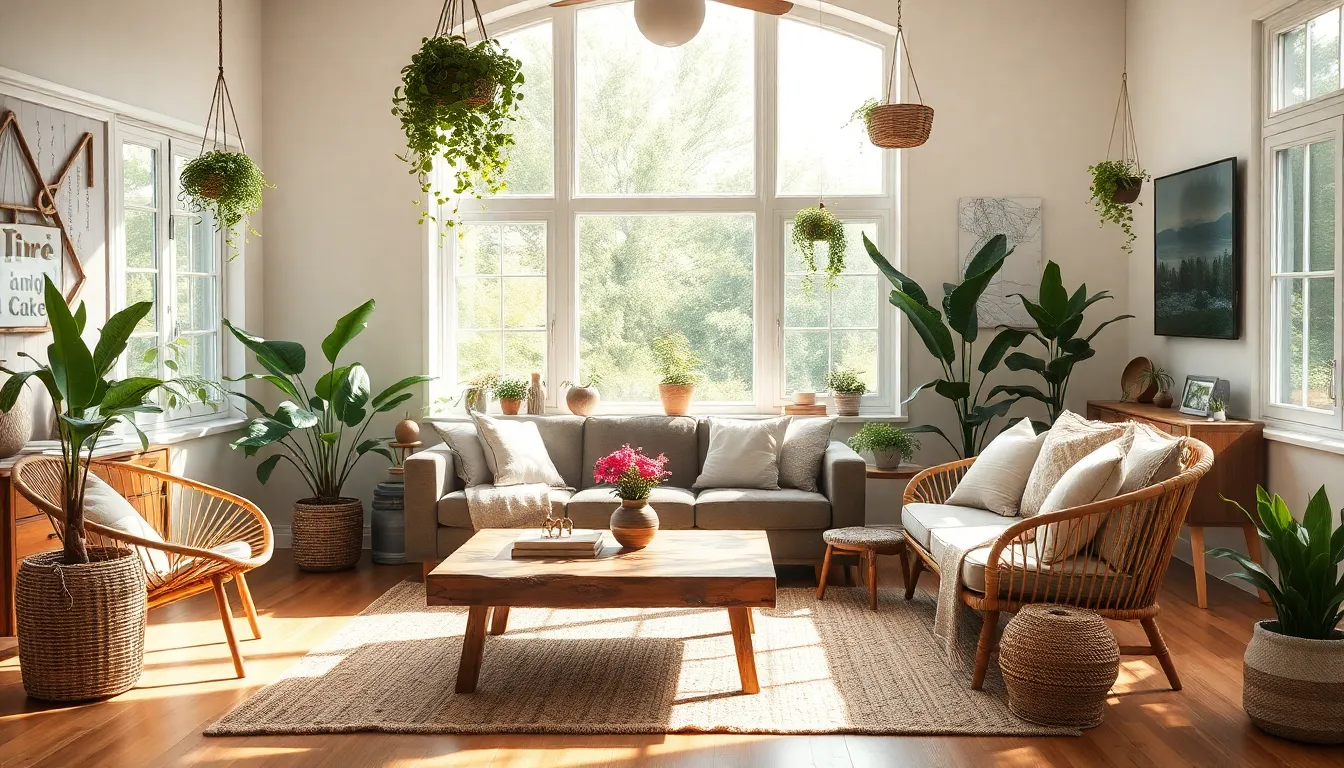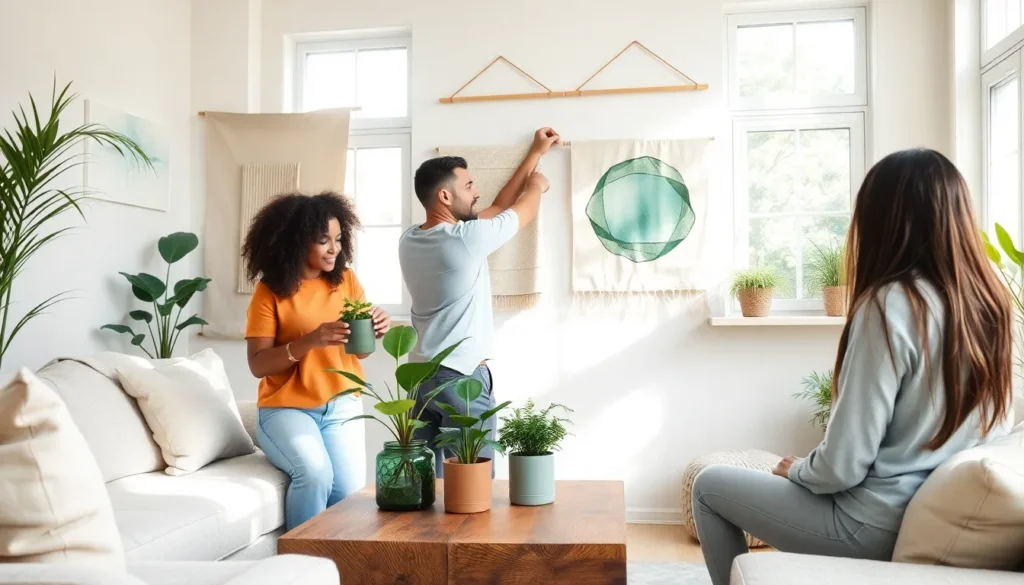Table of Contents
ToggleImagine transforming your home into a sanctuary that not only looks stunning but also gives Mother Earth a big hug. Eco-friendly decor isn’t just a trend; it’s a lifestyle choice that combines style with sustainability. From reclaimed wood furniture to organic textiles, it’s possible to create spaces that are both chic and conscious.
What Is Eco-Friendly Decor?
Eco-friendly decor emphasizes ecology and sustainability in design choices. It incorporates materials that minimize environmental impact, enhancing both aesthetics and functionality. Sustainable options include reclaimed wood, bamboo, and recycled glass, all commonly used in furniture and design elements.
Natural fibers play a significant role in eco-friendly textiles. Organic cotton, hemp, and linen create beautiful upholstery without harmful chemicals. Many decor items utilize non-toxic paints and finishes, ensuring safety for both inhabitants and the environment.
Green design prioritizes energy efficiency as well. Using energy-efficient lighting fixtures, such as LED bulbs, reduces electricity consumption significantly. Well-insulated windows and doors also enhance energy savings while maintaining comfort.
Plant integration serves dual purposes in eco-friendly decor. Incorporating indoor plants improves air quality and adds a touch of nature to spaces. Vertical gardens provide a unique visual aesthetic while promoting biodiversity.
Sourcing local materials supports eco-friendly decor choices. Local artisans and businesses contribute to sustainability by reducing transportation emissions. Connecting with communities fosters economic growth while preserving cultural heritage.
Decorating with a purpose reinforces personal values. Mindful consumption enhances individual styles without compromising environmental responsibilities. This approach ensures a harmonious balance between luxury and sustainability, leading to a fulfilling lifestyle.
Benefits of Eco-Friendly Decor

Eco-friendly decor provides numerous advantages, significantly enhancing interior spaces while protecting the environment. It contributes to a healthier planet and promotes well-being in everyday living.
Environmental Impact
Eco-friendly decor prioritizes sustainable materials, leading to reduced environmental harm. Sustainable furniture and textiles utilize resources like reclaimed wood, bamboo, and recycled glass, minimizing deforestation and pollution. These materials promote biodiversity and conservation efforts. Using local products reduces carbon footprints due to decreased transportation needs. Adopting energy-efficient solutions, such as LED lighting, cuts down on energy consumption, contributing to lower greenhouse gas emissions. Choosing eco-friendly decor drives a significant positive impact on natural ecosystems and encourages mindful consumption.
Health Advantages
Eco-friendly decor promotes healthier living environments through its use of non-toxic materials. Organic textiles, such as cotton, hemp, and linen, maintain safety by avoiding harmful chemicals often found in conventional fabrics. Enhanced air quality results from incorporating plants into home design, which filters pollutants and increases oxygen levels. Natural materials also help regulate indoor humidity, promoting comfort and well-being. Reducing exposure to toxins leads to better health outcomes and contributes to a serene atmosphere. Ultimately, eco-friendly decor improves overall quality of life while maintaining a commitment to sustainability.
Types of Eco-Friendly Decor
Eco-friendly decor encompasses a range of styles and materials that promote sustainability while enhancing aesthetic appeal. Individuals increasingly prioritize eco-conscious choices in their living spaces.
Sustainable Materials
Sustainable materials play a crucial role in eco-friendly decor. Bamboo, reclaimed wood, and cork represent excellent options, as they grow rapidly and minimize environmental impact. Organic cotton and linen deliver safe textile choices, free from harmful chemicals. Utilizing sustainably sourced materials reduces deforestation and lowers carbon footprints. Installing low-VOC paints also enhances indoor air quality while maintaining vivid colors. When prioritizing these materials, homeowners contribute to a healthier planet and attractive environments.
Upcycled and Recycled Items
Upcycled and recycled items contribute to eco-friendly decor by transforming waste into functional art. Furniture made from recycled materials often features unique designs that add character to spaces. Upcycling old furniture provides opportunities for creativity, turning worn pieces into stylish statements. Choosing decor items crafted from repurposed materials fosters innovative designs while minimizing landfill waste. Incorporating these items into a home demonstrates support for sustainable practices and helps cultivate a more eco-conscious lifestyle. Reclaimed glass, metal, and plastic can each serve decorative purposes, highlighting the beauty of environmental responsibility.
How to Incorporate Eco-Friendly Decor in Your Home
Incorporating eco-friendly decor enhances home aesthetics while promoting sustainability. Making responsible choices leads to a beautiful, environmentally conscious space.
Choosing the Right Products
Selecting sustainable materials ensures minimal environmental impact. Look for products crafted from renewable resources like bamboo and reclaimed wood. Choosing low-VOC paints maintains indoor air quality, proving beneficial for health. Sustainable textiles made from organic cotton or hemp provide comfort without toxins. Prioritizing items with certifications like FSC or Green Seal guarantees responsible sourcing. Recycled glass and metal products add unique visual appeal while reducing waste.
Designing a Sustainable Space
Creating a sustainable space involves thoughtful arrangement and design elements. Incorporating natural light through well-placed windows promotes energy efficiency. Utilizing plants not only enhances decor but also improves air quality. Opting for multifunctional furniture maximizes space use while minimizing consumption. Incorporating local crafts supports community artisans and reduces transportation emissions. Crafting a harmonious blend of style and sustainability creates inviting environments that reflect personal values.
Embracing eco-friendly decor not only beautifies living spaces but also fosters a sustainable lifestyle. By choosing materials that are both stylish and environmentally responsible, individuals can create homes that reflect their values. Incorporating natural elements and energy-efficient solutions enhances well-being while positively impacting the planet.
As people become more mindful of their consumption habits, the shift toward eco-friendly decor will continue to grow. This movement not only supports local artisans but also contributes to healthier living environments. Ultimately, eco-friendly decor serves as a reminder that style and sustainability can coexist harmoniously, paving the way for a brighter future.







